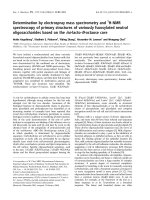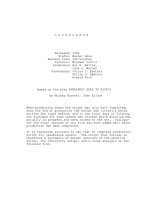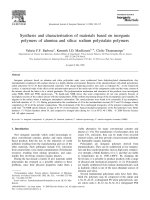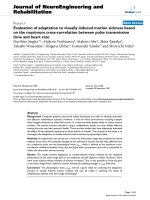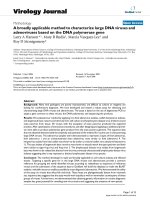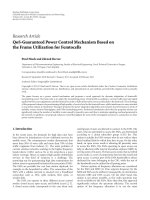Designing and querying XML views based on the ORA SS data model
Bạn đang xem bản rút gọn của tài liệu. Xem và tải ngay bản đầy đủ của tài liệu tại đây (1.51 MB, 201 trang )
DESIGNING AND QUERYING XML VIEWS
BASED ON THE ORA-SS DATA MODEL
CHEN YA BING
(Master of Engineering, Tianjin University, China)
A DISSERTATION SUBMITTED
FOR THE DEGREE OF DOCTOR OF PHILOSOPHY
DEPARTMENT OF COMPUTER SCIENCE
NATIONAL UNIVERSITY OF SINGAPORE
2005
i
Acknowledgements
The research presented in this thesis was carried out at the Department of Computer
Science, National University of Singapore. Many, Many people have helped me not
to get lost during the development of this thesis.
Prof. Ling Tok Wang, my main supervisor, has provided a motivating, enthusiastic
and critical atmosphere during the many discussions we had. He has patiently guided
and advised me throughout the various phases of the research. He has also impressed
upon me the importance of critical thinking as a researcher. It was a great pleasure to
me to conduct the research under his supervision. Dr. Lee Mong Li, as my second
supervisor has provided constructive and inspiring discussions which have many
times clarified my ideas. She has also improved both my technical writing and
presentation skills. I am very grateful to both of them for their encouragement and
support.
I also wish to express my gratitude to Ms. Cheng Qiong for many valuable
discussions for the research in the thesis. Finally, I would like to thank Mr. He Qi and
Mr. Fa Yuan for their useful comments during the course of my work.
ii
Summary
XML is emerging as the standard format for data exchange over the Internet. As the
amount of XML data increases dramatically, XML views are generally presented on
top of source data to enable data exchange. In this thesis, we develop a systematic
approach to design valid XML views, and devise two methods to automatically
generate query expressions for XML views. These techniques are introduced below:
• Design valid XML views: Existing systems for XML views only support select
operation applied in the views and do not guarantee that the designed views are
valid in terms of semantics. We propose a novel method to design valid yet
flexible XML views based on the semantically rich Object-Relationship-Attribute
model designed for SemiStructured data (ORA-SS), which can express semantics
that cannot be expressed in other data models such as XML, DTD or XML
Schema, etc. We identify four main view operators for creating XML views,
namely, select, drop, join and swap operators. For each operator, we develop a set
of rules to guide the design of valid XML views. These rules guarantee the
designed views are valid once a view operator is applied.
• Generate XQuery view definitions: After designing valid XML views based on
the ORA-SS data model with our view operators, we need to generate query
expressions for the valid XML views. If the XML data are stored in a native XML
database or as XML documents, we develop an algorithm to automatically
generate XQuery expressions for the views so that XQuery can be directly
executed against XML documents. Further, in cases where a view only involves
iii
the select operator and does not change the structure of the source schema, the
algorithm generates the XQuery expression for the views in a more efficient way.
• Generate SQLX view definitions: XML source data are not only stored in native
form, but are also increasingly being stored in object-relational databases. Thus,
we also develop a method to automatically generate SQLX query expressions for
the views. SQLX is the standard extension to SQL for supporting retrieving XML
data from traditional databases. By executing SQLX view definitions against the
databases, we can directly produce XML view results. The algorithm can
efficiently generate the SQLX view definition for an arbitrary ORA-SS view
designed with our view operators.
Based on the proposed approach, we develop a CASE tool for users to design valid
XML views, generate query expressions for the views and execute the query
expressions to produce the view documents. To the best of our knowledge, our work
is the first to employ a semantic data model for the design and query of XML views.
In summary, using a conceptual model for designing and querying XML views not
only validates XML views, but also provides a fast and user friendly approach to
retrieve XML data.
iv
Table of Contents
Acknowledgements i
Summary ii
Table of Contents iv
Table of Figures vii
1. Introduction 1
1.1. Background 1
1.1.1. eXtensible Markup Language (XML) 1
1.1.2. XML Technologies 4
1.1.3. XML Data Management 5
1.2. Problem Statement & Motivation 6
1.3. Research Contributions 10
1.4. Thesis Overview 11
2. Data Models for XML Data 13
2.1. XML DTD 14
2.2. XML Schema 18
2.2.1. Simple types in XML Schema 18
2.2.2. Complex types in XML Schema 19
2.3. OEM Data Model 23
2.4. ORA-SS Data Model 26
2.5. Summary 30
3. Designing Valid XML Views 32
3.1. Motivation 33
3.2. Pre-Processing Steps 37
3.2.1. Extract ORA-SS Source Schema from XML Documents 37
3.2.2. Enrich ORA-SS Source Schema with Semantics 38
3.3. View Design Rules 38
3.3.1 Select Operator 39
3.3.2. Drop Operator 40
3.3.3. Join Operator 48
v
3.3.4. Swap Operator 53
3.3.5. Aggregate and Order by Operators 63
3.3.6. Design Rules for Participation Constraints in Relationship 64
3.3.7. Design Rules for IDentifier Dependency Relationship 70
3.4. View Validation Algorithm 73
3.5. Summary 74
4. Generating XQuery View Definitions 76
4.1. XQuery Syntax 77
4.2. Motivating Example 82
4.3. Rules for Generating XQuery View Definitions 87
4.3.1. Main Idea 87
4.3.2. Analyzing Vpath 89
4.3.3. Rules for Generating Condition Constraints of an Object Class 92
4.3.4. Rules for Generating Attributes Attached to an Object Class 107
4.4. Improvements 113
4.4.1. Reducing redundant condition constraints 114
4.4.2. Views involving only selection operators 117
4.5. Illustrating Example 121
4.6. XQuery View Definitions Generation Algorithm 124
4.7. Algorithm Analysis 127
4.8. Summary 129
5. Generating SQLX View Definitions 130
5.1. The O-R Database Storage for XML based on ORA-SS 131
5.2. SQLX Syntax 133
5.3. Motivating Example 135
5.4. Rules for Generating SQLX View Definitions 138
5.4.1. Main Idea 138
5.4.2 DRTs in ORA-SS Views 139
5.4.3 Generation Rules 141
5.5. Illustrating Example 156
5.6. SQLX View Definitions Generation Algorithm 159
5.7. Algorithm Analysis 161
5.8. Summary 163
6. CASE Tool 164
vi
6.1. Function 1 – Designing valid XML views 165
6.1.1. Load ORA-SS source schema 165
6.1.2. Design views based on source schema 167
6.2. Function 2 – Generating SQLX View Definitions 170
6.3. Function 3 – Producing an XML View Document 171
7. Related Work 173
7.1. Emergence of XML Data Management 173
7.2. View Mechanism in RDB & OODB 175
7.3. XML Views on Relational Data 176
7.4. XML Views on XML Data 177
7.5. XML Views on Integration Systems 180
7.6. Summary 181
8. Conclusions 182
8.1. Summary of Thesis Work 182
8.2. Future Research Directions 184
Bibliography 186
vii
Table of Figures
Figure 1.1 An XML document on courses and students…………………………….2
Figure 1.2 Architecture of designing and querying XML views based on ORA-SS 11
Figure 2.1 An XML document on students and courses……………………………13
Figure 2.2 The XML DTD for the XML document in Figure 2.1………………… 16
Figure 2.3 The simple type definition for age with restriction………………………19
Figure 2.4 The complex type definition for employee………………………………20
Figure 2.5 An XML schema for the XML document in Figure 2.1………………….22
Figure 2.6(a) The OEM model for the XML document in Figure 2.1……………….24
Figure 2.6(b) The Dataguide for the XML document in Figure 2.1……………….25
Figure 2.7 The ORA-SS schema for the XML document in Figure 2.1…………….29
Table 2.1 Comparison of XML DTD, XML Schema, OEM/Dataguide
& ORA-SS……………………………………………………………… 30
Figure 3.1 An XML document on project, supplier and part……………………… 34
Figure 3.2 The ORA-SS source schema of the XML document in Figure 3.1………34
Figure 3.3 The XML DTD of the XML document on Figure 3.1………………….35
Figure 3.4 Invalid XML view …………………………………………………… 36
Figure 3.5 Valid XML view……………………………………………….…………36
Figure 3.6 The XML view applied with a selection operator on Figure 3.2……… 39
Figure 3.7 The XML view dropping supplier in Figure 3.2……………………….40
Figure 3.8 An ORA-SS source schema ………….………………………………… 43
Figure 3.9 The invalid view schema by dropping supplier ……………………….43
Figure 3.10 The valid view schema by dropping supplier …………………………43
Figure.3.11 An ORA-SS source schema ………………. ……………………… 46
Figure 3.12 The invalid view schema …………… …………………………… ….46
Figure 3.13 The valid view schema……………………… ………………… ……46
Figure 3.14 An ORA-SS schema diagram………………………………………….47
Figure 3.15 The ORA-SS view schema by joining supplier’ and supplier…… 48
Figure 3.16 An ORA-SS source schema………………………………………… 51
Figure 3.17 The invalid view schema by joining supplier’ and supplier ……… 51
viii
Figure 3.18 The valid view schema by joining supplier’ and supplier ….……… 52
Figure.3.19 An ORA-SS source schema ………………………………………… 52
Figure 3.20 The ORA-SS view schema swapping supplier and part in Figure 19…52
Figure 3.21 Rel_Set_1(Oi, Oj, S) in an ORA-SS source schema S ……………….54
Figure 3.22 Rel_Set_2(Oi, Oj, S) & Rel_Set_4(Oi, Oj, S) in an ORA-SS source
Schema S………………………………………………………………54
Figure 3.23 The ORA-SS source schema for Swapping O
i
and O
j
……… ……….57
Figure 3.24 The ORA-SS view schema for Swapping O
i
and O
j
………………… 57
Figure 3.25 An ORA-SS source schema for illustrating reversible issue………… 60
Figure 3.26 The invalid ORA-SS view schema swapping course and student in
Figure 3.27…………………………………………………………… 60
Figure 3.27 The valid ORA-SS view schema swapping course and student in
Figure 3.27…………………………………………………………… 61
Figure 3.28 The valid ORA-SS view schema swapping course and student again in
Figure 3.29…………………………………………………………… 61
Figure 3.29 The ORA-SS view schema by applying aggregate operator……………62
Figure 3.30 The ORA-SS view schema by applying order by operator……………62
Figure 3.31 Change of participation constraint due to a swap operator…………….64
Figure 3.32 Functional Dependency Diagram……………………………………….65
Figure 3.33 Change of Participation Constraint due to a projection operation……65
Figure 3.34 An ORA-SS source schema of an IDD relationship type……………….70
Figure 3.35 An ORA-SS view schema of swapping employee and child………… 70
Figure 3.36 An ORA-SS view schema of dropping employee………………………70
Figure 4.1 A sample XML document named book.xml…………………………… 77
Figure 4.2 An XQuery issued on the document book.xml………………………… 80
Figure 4.3 The result of the XQuery in Figure 4.2………………………………… 80
Figure 4.4 A source XML file……………………………………………………… 82
Figure 4.5 The ORA-SS source schema…………………………………………… 82
Figure 4.6 The ORA-SS view schema……………………………………………….82
Figure 4.7 The instance diagram for the source in Figure 4.2……………………….82
Figure 4.8 The instance diagram for the view in Figure 4.3…………………………82
ix
Figure 4.9 The view definition in XQuery expression for view in Figure 4.6………83
Figure 4.10 The XML instance for the view in Figure 4.6… ………………………85
Figure 4.11(a) Two simplified ORA-SS source schema………………………… 90
Figure 4.11(b) One simplified ORA-SS view schema………………………… 90
Figure 4.12(a) The case for rule Type I_A…………………………………………94
Figure 4.12(b) Condition constraints generated in Rule Type I_A………………….94
Figure 4.13(a) The case for Rule Type I_B……………………………………… 95
Figure 4.13(b) Condition constraints generated in Rule Type I_B……………… 95
Figure 4.14(a) The case 1 for Rule Type II_A…………………………………….97
Figure 4.14(b) The case 2 for Rule Type II_A……………………………………97
Figure 4.15(a) The Case for Rule Type II_B……………………………………….98
Figure 4.15(b) Condition constraints generated in Rule Type II_B……………… 98
Figure 4.16 The Case for Rule Type III_A…………………………………………100
Figure 4.17(a) The Case for Rule Type III_B………………………………………102
Figure 4.17(b) Where condition generated in Rule Type III_B…………………….102
Figure 4.18(a) The case for Rule Type III_C………………………………………103
Figure 4.18(b) Where condition generated in Rule Type III_C……………………103
Figure 4.19(a) The case for Rule Type III_D………………………………………104
Figure 4.19(b) Where condition generated in Rule Type III_D……………………104
Figure 4.20 The generated clause for Rule Attribute_1…………………………….107
Figure 4.21 The generated clause for Rule Attribute_2…………………………….107
Figure 4.22 The generated clause for Rule Attribute_3…………………………….108
Figure 4.23 The generated clause for Rule Attribute_4……………………………109
Figure 4.24 The generated clause for Rule Attribute_5…………………………….110
Figure 4.25 The generated clause for Rule Attribute_6……………………………111
Figure 4.26 An ORA-SS view schema diagram……………………………………113
Figure 4.27 an ORA-SS view schema diagram applying a selection operator in
Figure 4.26……………………………………………………………117
Figure 4.28 The XQuery expression for the view in Figure 4.27………………… 117
Figure 4.29 An ORA-SS source schema……………………………………………120
Figure 4.30 The ORA-SS view schema based on Figure 4.28…………………….120
x
Figure 4.31. The XQuery view definition for ORA-SS view schema in
Figure 4.30……………………………………………………………121
Figure 5.1 An ORA-SS source schema……………………………………………131
Figure 5.2 OR storage schema for the ORA-SS schema in Figure 5.1…………… 131
Figure 5.3 Object-Relational database of relations supplier and sp……………… 133
Figure 5.4 An SQLX query to retrieve all suppliers of part “p01” and prices… …134
Figure 5.5 An instance result for the query in Figure 5.4………………………… 134
Figure 5.6 The ORA-SS Source Schema……………………………………… …135
Figure 5.7. The ORA-SS View Schema by swapping supplier and part on
Figure 5.6………………………………………………………………135
Figure 5.8. The SQLX View definition for the view in Figure 5.7……………… 135
Figure 5.9 An ORA-SS source schema…………………………………………… 139
Figure 5.10 The ORA-SS view schema based on Figure 5.9………………………139
Figure 5.11 An ORA-SS view containing project, supplier & part………………141
Figure 5.12 The query expression for part……………………………………… 143
Figure 5.13 The query expression for employee………………………………… 147
Figure 5.14 The query expression for project with relationship type pj……………148
Figure 5.15 The query expression for project with relation spj…………………….148
Figure 5.16 The query expression for factory with relationship type pf……………149
Figure 5.17 The query expression for factory with relation ps and sf…………… 149
Figure 5.18 The query expression for employee with attribute progress………… 151
Figure 5.19 The query expression for project with attribute total_qty…………… 151
Figure 5.20 The query expression for employee with attribute email………………153
Figure 5.21 The SQLX view definition for the view schema in Figure 5.1……… 155
Figure 6.1 The Architecture of the CASE Tool……….……………………………162
Figure 6.2 An sample XML document for an ORA-SS source schema ………164
Figure 6.3 Load a source schema in the GUI interface……………………………165
Figure 6.4 Operate an object class in the GUI interface……………………………166
Figure 6.5 Operate an attribute in the GUI interface……………………………….167
Figure 6.6 Generate SQLX view definition in the GUI interface………………… 168
Figure 6.7 Produce output view document in the GUI interface…………………169
1
Chapter 1
Introduction
In this chapter, we introduce the background of XML, which includes the concept of
XML, the related technologies of XML and some issues in XML data management.
Next, we present the research problems that we have addressed in the thesis, followed
by our research contribution.
1.1. Background
1.1.1. XML
The eXtensible Markup Language (XML) [39] was originally designed as a new
document format for large-scale electronic publishing, which is derived from the
Standard Generalized Markup Language (SGML). As a markup language, however,
XML is playing an increasingly important role in the exchange of a wide variety of
data on the Web. It is because XML is able to describe both structured and semi-
structured data. In addition, XML is extensible, platform-independent, and fully
Unicode compliant.
XML identifies data using tags, which are identifiers enclosed in angle brackets.
Collectively, the tags are known as “markup”. An XML document always starts with
a prolog markup. The minimal prolog contains a declaration that identifies the
document as an XML document. In general, there are five main markups in XML:
element, entity, comment, processing instruction and marked section.
Chapter 1. Introduction
2
The most commonly used markup in XML data is element. Element identifies the
content it surrounds. Element can also contain attributes that are name-value pairs as
additional information of the element. The markup entity is used to represent some
special characters that have been reserved in XML. The markup comments in XML
are the same as HTML comments. They can be placed between markups anywhere in
XML data. The markup processing instructions gives information or commands to an
application that is processing the XML data. Finally, the markup marked section is
also called CDATA section. It instructs the XML parser to ignore markup characters
in this section. In the case where a piece of source code including characters that the
XML parser would ordinarily recognize as markup is listed in XML data, a CDATA
section can be used.
Figure 1.1. An XML document on courses and students
Example 1.1. Figure 1.1 depicts a simple XML document. It starts with a prolog
markup that identifies the document as an XML document that conforms to version
<?xml version=”1.0” encoding=”UTF-8” ?>
<! An XML file on courses and students - ->
<! Processing Instruction - ->
<?my.presentation.program Query=”which course”?>
<doc>
<faculty name=“School of Computing”>
<course cno=“cs321”>
<title>software engineering</title>
<student sno=“s001”>
<name>paul</name>
<information> grade < expected </information>
<information><![CDATA[<<<<<a test cdata>>>>>]]></information>
<grade>C</grade>
</student>
<student sno=“s002”>
<name>mike</name>
<information> grade > expected </information>
<grade>A+</grade>
</student>
</course>
</faculty>
</doc>
Chapter 1. Introduction
3
1.0 of the XML specification and uses the 8-bit Unicode character encoding scheme.
Next, there are two lines of comments, which will be ignored by XML parsers. After
that, a processing instruction is presented for a program called
“my.presentation.program” that will query the user to find out which course to
display. The root element of the document follows the processing instruction, which
is named doc element. Generally, each XML document has a single root element.
Next, there is an element faculty along with an attribute name, whose value is School
of Computing to identify the name of the faculty. Under the faculty, there is a sub
element course with attribute code = “cs321”, whose title is “software engineering”.
Under this course, there are sub elements students that identify the students taking
this course. Each student element contains information about the student, which
includes the key attribute of the student, i.e., sno, the name of the student and the
grade of the student for the course.
For illustration purpose, each student has an information sub element to indicate
whether the grade is greater than expected or not. The entity references such as
“>” or “<” are used in the elements to represent the symbol “>” or “<”. A
CDATA section is also added in the second information element of the first student
element. The CDATA section starts with <![CDATA[ and ends with ]]>. It can be
used in the case where large blocks of XML include many of the special characters.
The text in the CDATA section will have arrived as it was written because XML
parsers do not treat it as XML. □
There are a number of reasons for XML’s surging acceptance. First of all, XML is in
plain text instead of binary format. An XML document can be easily created and
Chapter 1. Introduction
4
edited with anything from a standard text editor to a visual development environment.
One advantage of plain text is that it allows people, if necessary, to read the data
without the program that produced it. That also makes it easy to debug applications.
Secondly, the nature of XML is extensible. Unlike HTML, XML does not have a
fixed vocabulary. Instead, one can define vocabularies specific to particular
applications or industries using XML. The extensibility of XML allows it to identify
not only structured data, but also semi-structured data. Thirdly, XML is platform
independent. It is not tied to any programming language or operating systems.
Currently, XML data can be produced, exchanged and consumed with a variety of
programming languages on the Internet. Platform independence makes XML very
useful as a means for achieving interoperability between different programming
platforms and operating systems.
1.1.2. XML Technologies
A number of XML related technologies have emerged for manipulating, structuring,
transforming and querying data. These include:
• XML schema languages. An XML schema language is used to describe the
structure and content of an XML document. There are several schema
languages existing for XML. Currently, XML DTD and XML Schema
Definition Language [41] (XSD) from W3C are widely accepted.
• Tree model-based APIs. An XML document is represented as a tree of nodes
with a tree model API. Typically, it loads an XML document in memory all at
once. The dominant tree model API is the W3C Document Object Model
Chapter 1. Introduction
5
(DOM) [37]. Developers can use the DOM for programmatic reading,
manipulation and modification of an XML document.
• Event-driven APIs. An event-driven API processes an XML document
without storing much more than the context of the current node being
processed in memory. The most popular event-driven API is the Simple API
for XML (SAX).
• XML Transformation. Developers often need to transform XML documents
from one vocabulary to another. The structure of XML documents also need
to be transformed so that they can be exchanged on the Internet. XSLT [38] is
the premiere XML transformation language. A transformation expressed in
XSLT describes rules for transforming a source tree into a result tree.
• XML Query. An XML query language provides an alternative way to retrieve
information from XML data other than the APIs for processing XML. The
W3C XQuery [40] is the standard for querying XML data. It provides flexible
query facilities to extract data from real and virtual documents on the Web.
Ultimately, collections of XML files will be accessed like databases.
1.1.3. XML Data Management
As XML becomes the standard for exchanging data on the Internet, more and more
data are stored and retrieved in XML format. Thus, there is a need to efficiently and
effectively manage XML data. There are many interesting topics on XML data
management [79] [84] [85]. Some of the main topics are listed below:
• Publishing relational data into XML. As most of commercial data are stored
in traditional databases such as relational or object-relational databases, there
Chapter 1. Introduction
6
is a need to export those data into XML form in order to exchange them on the
Internet. It will also be useful for web publishing and data integration.
Publishing languages are frequently adopted to define the mapping between
relational data and XML data. Alternatively, intermediate schema can also be
extracted from relational data before they are mapped into XML data. In this
case, XML views are always presented to users so that users can retrieve the
underlying data through the XML views.
• Storing XML data. The basic way to store XML data is to store them as text
files, which offers a fast solution for storing and retrieving whole documents.
There are also two other ways for storage. One is to design native XML
databases, which stores XML documents as it is and offers database
functionalities, such as index, query facility, etc. The other is to employ
relational or object-relational databases to map XML data into a set of tables.
• XML data integration. As a standard for exchanging data, XML plays a
critical role in data integration because of the large amounts of heterogeneous
distributed web data. XML schema can be extracted from these data and
integrated as one global XML schema. Users can issue XML queries on the
integrated schema, which are then decomposed into local queries against
source data. Finally, results of local queries are integrated into the result of the
original XML query.
1.2. Problem Statement & Motivation
In this thesis, we focus on one particular issue in XML data management – presenting
XML views on XML data. There are several advantages for XML views. Firstly,
Chapter 1. Introduction
7
XML views provide application specific views of source data. Secondly, XML views
secure the source data by hiding the part users are not allowed to see. Thirdly, XML
views provide for a basis for further data integration. Finally, XML views enable us
to exploit the potential of XML as the standard of data exchange.
Most of current systems [11] [14] [18] [43] [31] [73] for XML views focus on
presenting XML views on relational data. Some of others also present XML views on
XML data [21] [64] [44] [52] [67]. Unfortunately, there are several shortcomings in
those systems.
Firstly, they do not guarantee the designed views are valid in terms of semantics. In
another words, the designed XML views may violate the semantics implied in XML
source data. In general, these systems uses query languages to define XML views on
source data. Users can define any views they want if the language can express it.
Thus, it is easy for such views to violate the semantics in source data especially in the
case where the semantics in source data are not explicitly expressed. The semantics to
be violated may include functional dependencies, key and foreign key constraints,
and relationship types, which exist in XML source data. To the best of our
knowledge, the related work does not consider such semantics in designing XML
views, which may results in invalid XML views.
Secondly, query expressions for XML views are generally complex and hard to
understand because of the tree structure of XML. As a simple example, an XML view
involving supplier, part and the price of a part supplied by one supplier may need 20
lines of XQuery expression. When an XML view has more elements and relationship
types, the query expression for the view will be explosively longer. Thus, the
Chapter 1. Introduction
8
probability of making errors in writing query expression is high if users manually
define XML views. It will not be user-friendly for users to manually write such query
expression for XML views. As a matter of fact, one solution for this issue is to
develop a CASE tool to enable users to design XML views graphically.
Finally, most current related work considers XML views on top of relational
database. That is, the source data for XML views are relational data. Some other work
considers XML views on top of XML data. That is, the source data are XML data.
However, currently no work considers designing flexible XML views for the case
where XML data are stored in traditional database. Thus, there is a gap to be filled.
We propose a systematic approach to allow XML views to be presented on XML
source data. The source data can be stored in native form or in an object-relational
database. In this way, we not only fill the gap mentioned before, but also cover more
generic cases where XML data are stored by using two different storage methods.
We also examine the design of valid XML views. We adopt a semantically rich data
model – Object-Relationship-Attribute model for Semi Structured data (ORA-SS)
[24] to express the schema of XML source data and XML views. We define a set of
view operators to design XML views based on ORA-SS data model. By employing
the semantics enriched in ORA-SS, we also develop a set of rules to guarantee that
the designed XML views are valid. As the schema of XML views are expressed in
ORA-SS, the schema for the XML views are thus called ORA-SS views. The
difference between XML views and ORA-SS views are as follows:
• XML views denote the XML documents for designed views.
Chapter 1. Introduction
9
• ORA-SS views denote the ORA-SS schema diagram of designed XML views.
In another words, an arbitrary XML view document can be called an XML view for
short. Its corresponding ORA-SS schema diagram can then be called an ORA-SS
view. Note that we assume that the ORA-SS schema must always be conformed to its
corresponding XML view in terms of semantics. We say an XML view is valid if it
does not violate the semantics implied in source data. Similarly, we say an ORA-SS
view is valid if it does not violate the semantics in its corresponding ORA-SS source
schema. Thus, as we show in this thesis, if an ORA-SS view is valid, then an XML
view conforming to the ORA-SS view is also valid. That is, the issue of the validity
of XML views is the same as the issue of the validity of ORA-SS views.
After we develop the set of rules for the validity of XML views or ORA-SS views,
we develop algorithms to automatically generate query definitions from the ORA-SS
views, as the ORA-SS views are graphical schema diagrams. When XML data are
stored in native form, XQuery [40] view definitions are generated from the ORA-SS
views. On the other hand, when XML data are stored in the object-relational database
system, SQLX [75] view definitions are generated from the ORA-SS views.
We formalize the issues addressed in this thesis above as follows:
Valid XML Views Problem. Given an ORA-SS source schema S of XML data D, and
a set of view operators, i.e. select, drop, join and swap, to design an ORA-SS view V,
develop a set of rules to guarantee V is valid once a view operator is applied in V.
XQuery View Definition Generation Problem. Given a designed valid ORA-SS view
schema V and its ORA-SS source schema S, as well as its source document D
Chapter 1. Introduction
10
generate an XQuery view definition for V, which can be directly evaluated on the
source data D with XQuery engines.
SQLX View Definition Generation Problem. Given a designed valid ORA-SS view
schema V and its ORA-SS source schema S, as well as its ORDB storage T generate a
SQLX view definition for V, which can be directly evaluated on the storage T.
1.3. Research Contributions
To solve the three problems discussed, we employ a semantically rich data model –
Object-Relationship-Attribute model for Semi Structured data (ORA-SS) [24] to
express the schema of XML data. Based on the ORA-SS data model, we propose a
novel approach to designing and querying XML views on XML source data. The
architecture of our approach is shown in Figure 1.2.
Firstly, an ORA-SS schema is extracted from XML data, XML DTD or XML
Schema as a pre-process task. The XML data are stored as XML files or in an object-
relational database. Based on the extracted ORA-SS schema, we employee a set of
view operators to design XML views. A set of rules have been developed to
guarantee the views are valid. After that, the designed XML views are processed, and
the corresponding view definitions are automatically generated. Two types of view
definitions are generated depending on which storage we adopt. One is XQuery view
definitions, which are executable against XML files. The other is SQLX view
definitions, which are executable against the object-relational database. By executing
those view definitions, the XML view documents can be directly produced.
Chapter 1. Introduction
11
Figure 1.2. The Architecture of designing and querying XML views based on ORA-SS
In summary, the several research contributions in this thesis are as follows.
1. Propose a set of view operators based on ORA-SS schema to design flexible yet
valid XML views.
2. Develop a set of rules to validate designed XML views for each operator applied
on ORA-SS source schemas.
3. Develop an algorithm to automatically generate XQuery view definitions for the
designed valid XML views in the case where XML data are stored in native form.
4. Develop an algorithm to automatically generate SQLX view definitions for the
designed valid XML views in the case where XML data are stored in an object-
relational database.
1.4. Thesis Overview
The rest of the thesis is organized as follows. Chapter 2 introduces some of the main
data models for XML data as well as the semantically rich ORA-SS data model. The
advantages of ORA-SS over other data models are also presented. Chapter 3 presents
the view operators based on ORA-SS schema as well as the set of rules for designing
Valid ORA-SS view schema
ORA-SS source schema
XML data
Designing
XQuery view
definitions
XML files
Extracting
Generating
Executing
An Object-relational
database
SQLX view
definitions
Executing
Chapter 1. Introduction
12
valid XML views for each of these view operators. Chapter 4 describes the algorithm
for automatically generating XQuery view definitions for XML views when the XML
data are stored in native form (XML files or native XML databases). Chapter 5 gives
the algorithm to automatically generate SQLX expressions for XML views for the
case where XML data are stored in an object-relational database. Section 6 presents
the CASE tool that we have implemented for the proposed approach. The related
work is given in chapter 7, and we conclude the thesis in chapter 8.
13
Chapter 2
Data Models for XML Data
XML can represent the structure of data instance. However, we still need a data
model to represent the schema of XML data. Since XML 1.0 was proposed, several
data models were proposed for XML with different features. In this chapter, some of
main data models for XML will be introduced, which include XML DTD, XML
Schema and OEM. Finally, ORA-SS data model, which has been adopted in the work
of this thesis, is presented.
Figure 2.1. An XML Document on students and courses
We use the XML document shown in Figure 2.1 to illustrate how these data models
express XML data. Figure 2.1 depicts an XML document on students,
<root>
<student sno=”s001”>
<sname>B. Cali</sname>
<course code=”cs1001” title=”Java programming”>
<grade>A</grade>
<faculty fno=”f001” fname=”T. Bray”/>
<tutor sno=”s401” sname=”B.McHugh”>
<payrate>20</payrate>
<feedback>good</feedback>
</tutor>
</course>
<course code=”cs1002’ title=”Introduction to Database”>
<grade>A+</grade>
<faculty fno=”f002” fname=”A. Milo”/>
<tutor sno=”s402” sname=”SY. Liu”/>
<payrate>25</payrate>
<feedback>excellent</feedback>
</tutor>
</course>
</student>
</root>
Chapter 2. Data Models for XML Data
14
their courses taken and faculty and tutor teaching the courses. The document only
shows one student with sno equal to s001, who takes two courses, which are cs1001
and cs1002. Each course’s grade of the student is also shown respectively. In addition,
for each course taken by the student, there is one faculty and one tutor teaching it,
which are presented as sub elements of course. Finally, the payrate of each tutor for
the course is also presented as a sub-element of tutor in the document. The value of
payrate depends on both course and tutor.
2.1. XML DTD
XML DTD [41] is the grammar along with XML 1.0 recommendation, which is
known as Document Type Definition. It defines XML document structure with a list
of markup declarations. It can be declared inline in an XML document, or as an
external reference. An XML document can be checked against its DTD to ensure the
document is valid. XML DTD may consist of three declarations: element declarations,
attribute declarations and entity declarations.
(1) Element declarations are used to declare the elements in an XML document. The
syntax of element declarations in DTD is as follows.
<!ELEMENT elementName elementContents>
The elementName in the element declarations denotes the name of the element. The
elementContents in the element declarations can be nested elements, #PCDATA,
EMPTY or ANY. In the case where the elementContents contain nested elements, there
are two symbols to separate the sub elements. One is “,”, which indicates each
subsequent element follows the preceding element. The other is “|”, which indicates

